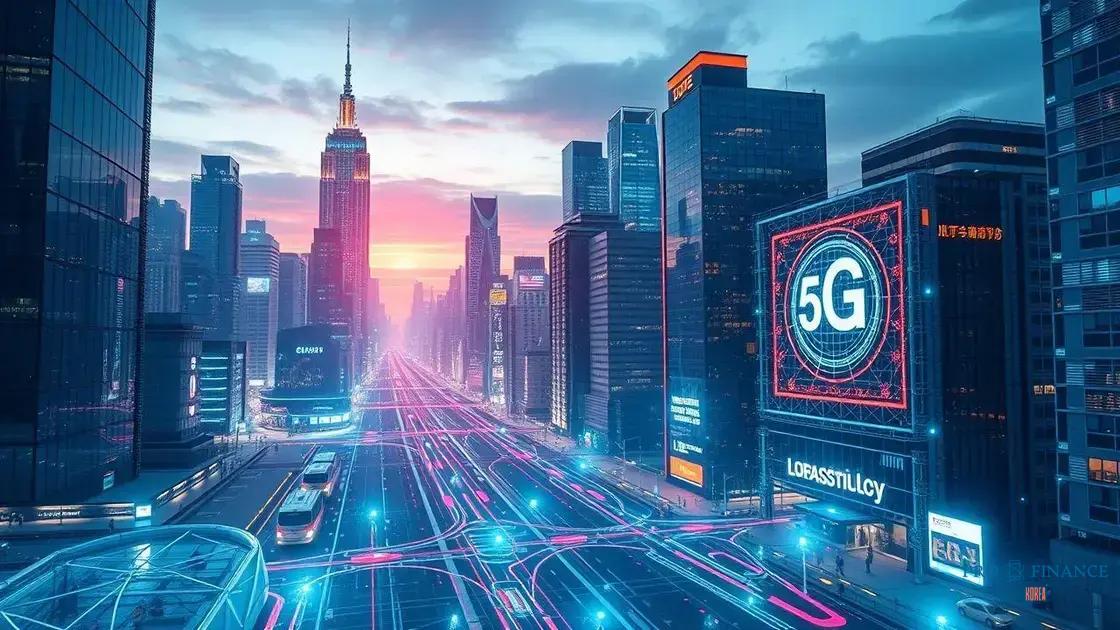The future of 5G networks and their impact on industries

The future of 5G networks will revolutionize industries by providing faster data speeds, improved connectivity, and innovative applications, significantly impacting areas such as healthcare, transportation, and smart city development.
The future of 5G networks and their impact on industries is a topic that sparks curiosity, as we stand on the brink of a connectivity revolution. Imagine a world where everything is seamlessly interconnected. Sounds exciting, right?
Understanding 5G technology
Understanding 5G technology is essential as we move toward a more connected world. It marks a significant advancement over previous generations of mobile networks, promising faster speeds and more reliable connections.
One of the key aspects of 5G is its ability to support a greater number of devices simultaneously. Unlike 4G, which can become congested during peak times, 5G networks can handle up to one million devices per square kilometer. This capability is crucial for the rise of the Internet of Things (IoT), where everyday objects are connected to the internet.
High-speed connectivity
Another major benefit of 5G is speed. In ideal conditions, 5G can offer speeds up to 100 times faster than 4G. This means downloads that used to take minutes can now happen in seconds, revolutionizing industries that rely on data transfer.
Lower latency
Furthermore, 5G technology boasts significantly reduced latency. Latency refers to the delay before a transfer of data begins following an instruction. With 5G, this delay is almost negligible, allowing for real-time communication that is crucial for applications like telemedicine and autonomous vehicles.
- Enhanced user experiences through faster browsing.
- Better support for cloud-based applications.
- Improved communication methods, such as augmented reality.
Additionally, 5G networks will utilize higher frequency bands, known as millimeter waves. These waves allow data to be transmitted faster and with greater capacity. However, they do have shorter ranges than lower frequency waves, necessitating more base stations to ensure coverage.
Ultimately, understanding 5G technology opens up a world of possibilities. Several industries, including healthcare, manufacturing, and entertainment, are poised to benefit greatly from this transformational technology. Its impacts will not only enhance current technologies but will also pave the way for innovation and new business models. As we embrace this new era of connectivity, the potential for growth and change is limitless.
Key benefits of 5G for businesses

The key benefits of 5G for businesses are transforming how companies operate. With its enhanced features, 5G is opening doors to new opportunities and efficiencies that were not possible before.
One of the standout advantages is faster data transfer speeds. Businesses can send and receive large amounts of data almost instantly, which is crucial for decision-making and real-time applications. This speed not only improves productivity but also enhances customer experiences.
Improved connectivity
Moreover, 5G significantly improves connectivity. Unlike earlier technologies, it can support a vast number of connected devices without compromising performance. This is especially beneficial for industries relying on IoT devices to gather data from multiple sources.
Enhanced mobile experiences
Additionally, 5G technology provides enhanced mobile experiences for users. Employees can access applications and data remotely without lag, which boosts collaboration and innovation. Businesses can also implement advanced solutions such as augmented reality and virtual reality, further engaging clients and enhancing training.
- Real-time analytics capabilities.
- Support for advanced applications, like telemedicine and remote monitoring.
- Greater operational efficiency through automation.
Another critical benefit is the lower latency provided by 5G. Latency is the time it takes for data to travel from the source to the destination. With minimized latency, businesses can react quickly to changes and improve overall responsiveness, which is invaluable in industries such as finance and logistics.
Furthermore, the adoption of 5G can lead to cost savings. By enabling more efficient operations, reducing downtime, and increasing the speed of processes, companies can allocate resources where they matter most.
How 5G is transforming communication
How 5G is transforming communication is a topic gaining significant attention. This technology is revolutionizing the way people and businesses interact, enabling seamless communication across various platforms.
One of the main ways 5G alters communication is through higher bandwidth. With increased capacity, users can share high-definition videos, large files, and complex data instantly. This change eliminates long waits and enhances overall user satisfaction.
Real-time communication
Moreover, 5G technology enables real-time communication, which is crucial for industries like healthcare and emergency services. For instance, doctors can conduct remote consultations with patients instantly, bridging the gap between healthcare providers and patients who cannot visit in person.
Enhanced collaboration tools
In addition, 5G allows for enhanced collaboration tools. With improved connectivity, teams can work together from different locations without interruption. This technology supports advanced applications, such as virtual reality meetings and augmented reality collaborations, making teamwork more interactive and engaging.
- Instant messaging and video calls become more reliable.
- High-quality streaming for webinars and online presentations.
- Improved customer service through quick response times.
Another significant transformation is in the realm of mobility. With 5G, users can stay connected even while on the move. This means that high-quality video calls and streaming services are available even in vehicles or crowded public spaces. Consequently, this fosters a culture of constant connection and accessibility.
Furthermore, the advent of 5G is empowering businesses to adopt advanced customer engagement strategies. By leveraging real-time data analytics, companies can understand user preferences better and tailor their communication strategies accordingly. This personalized approach strengthens the relationship between brands and their customers.
Challenges of implementing 5G networks

The challenges of implementing 5G networks are significant, yet understanding these challenges is crucial for successful deployment. As businesses and communities prepare for this next generation of connectivity, several hurdles must be addressed.
One major challenge is the infrastructure requirements. Building a 5G network necessitates a dense network of small cell towers to provide coverage. This higher density demands substantial investments and thoughtful planning to ensure that areas receive consistent service.
Regulatory hurdles
Moreover, regulatory hurdles can slow down the rollout of 5G. Different regions have various regulations regarding zoning and permits for new towers. Navigating these legal frameworks can take time, resulting in delays for carriers looking to enhance their networks.
Cost considerations
Cost is also a significant concern for many service providers. The financial burden of upgrading existing systems and deploying new infrastructure can be overwhelming. Companies must weigh the benefits against the high initial investment and consider long-term returns.
- Funding challenges for necessary upgrades.
- Competition among providers for limited resources.
- Potential economic impact during the implementation phase.
Another obstacle is the technical complexity of 5G systems. Transitioning from 4G to 5G involves integrating cutting-edge technologies and a variety of devices. These advancements require specialized knowledge and training for technicians, adding to the complexity of the rollout.
Lastly, security concerns also pose a challenge. With the increased connectivity of devices, the potential for security breaches rises. Ensuring strong cybersecurity measures are in place is vital to protect data and maintain user trust in new technology.
Future trends in 5G applications
The future trends in 5G applications are exciting and promise to change the landscape of technology and business. As adoption increases, we can expect innovative uses that will enhance various industries.
One of the most anticipated trends involves smart cities. With 5G’s capability to connect many devices, cities can become more efficient. Data collected from sensors can help manage traffic flows, optimize energy usage, and improve public safety.
Healthcare advancements
Another area where 5G will have a profound impact is healthcare. Remote patient monitoring and telehealth services will become more reliable and widespread. Surgeons could perform procedures remotely using real-time video feeds and robotic systems. This could greatly expand access to medical care, especially in rural areas.
Autonomous vehicles
The rise of autonomous vehicles is also a key trend. These vehicles will rely on 5G for constant communication with other cars and infrastructure. This communication is essential for making split-second decisions and improving road safety.
- Increased use of augmented reality in training and customer experiences.
- Advancements in real-time analytics for better decision-making.
- Improved virtual reality applications for gaming and entertainment.
Moreover, industries such as manufacturing will undergo a transformation through smart factories. The integration of 5G technology with the Internet of Things (IoT) will allow machines to communicate and optimize their operations automatically, increasing productivity and reducing downtime.
Finally, as more devices connect through 5G, there will be a rise in machine-to-machine communication. This will enable automated processes in households and workplaces, making everyday tasks more efficient. For example, refrigerators can reorder groceries as items are used, enhancing convenience for consumers.
FAQ – Frequently Asked Questions about the Future of 5G Networks
What is the primary benefit of 5G technology?
The primary benefit of 5G technology is faster data transfer speeds, which enhance user experiences and enable innovative applications in various industries.
How will 5G impact healthcare?
5G will allow for real-time remote monitoring and telehealth services, enhancing access to medical care and improving patient outcomes.
What challenges are associated with implementing 5G networks?
Challenges include the need for extensive infrastructure, regulatory hurdles, high costs, and technical complexities that must be addressed for successful deployment.
What future trends can we expect from 5G applications?
Future trends include the development of smart cities, advancements in autonomous vehicles, improved healthcare technologies, and increased machine-to-machine communication.






